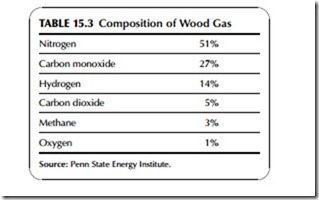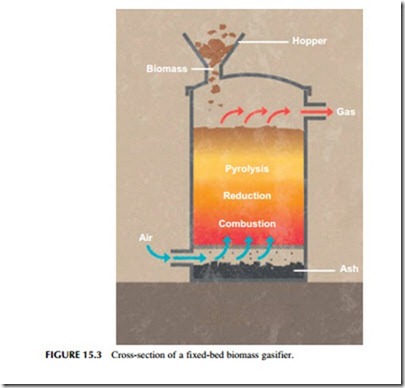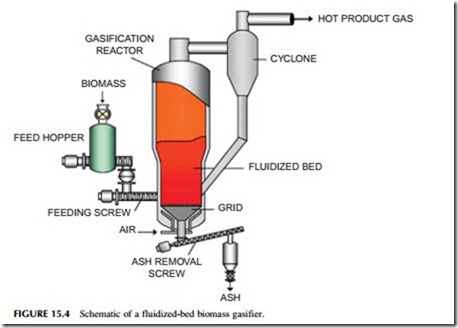BIOMASS GASIFICATION
Gasification involves the heating of biomass in a reducing atmosphere with the addition of water vapor to generate a gas that contains around 40% hydrogen and carbon monoxide with most of the remainder being nitrogen. The compo- sition of a typical wood gas from a gasifier is shown in Table 15.3. Further reaction can convert the carbon monoxide into more hydrogen if required and the gas will usually be cleaned before combustion. Wood gas has a low calorific value between 4 MJ/m3 and 19 MJ/m3; by comparison the calorific value of natural gas is around 38 MJ/m3.
There are two types of gasifier used for biomass gasification: a fixed bed and a fluidized bed. The fixed bed is the simplest type, comprising a cylindrical vessel with a grate at the bottom, as shown in Figure 15.3. Biomass is introduced at the top and air from the bottom, and the heat for the gasification process is pro- vided by the partial combustion of the biomass. Ash is then removed from the bottom of the gasifier. Fixed-bed gasifiers are relatively primitive and inefficient and are generally only used at capacities of 5 MW of less.
The alternative, a fluidized-bed gasifier, is similar to the fluidized-bed com- bustor described previously but is operated with a reduced supply of air so that combustion cannot go to completion (Figure 15.4). The heat content of the gas from both types of gasifier is often less than 6 MJ/m3. The low-quality gas from
a fixed-bed gasifier has limited use and will normally be burned to raise steam to drive a steam turbine. The gas from a fluidized-bed gasifier can potentially be utilized in a gas turbine, a reciprocating engine, or a fuel cell too.
One of the potentially most interesting gasification configurations is the biomass-based integrated gasification combined cycle (IGCC) plant. Plants of this type have been developed for coal combustion and form one of the future options for carbon dioxide capture and storage from coal-fired power stations. In a biomass IGCC plant, biomass is gasified, cleaned, and burned in a gas turbine. The hot exhaust gases from the gas turbine are then used to raise steam to drive a supplementary steam turbine. With close integration of the plant components, an overall efficiency of 45% might be achieved. A further advantage of this type of plant is that since biomass is carbon neutral, no carbon dioxide capture is necessary.
Alternative ways of exploiting low-quality biogas include the use of an organic Rankine cycle turbine similar to that used to generate electricity from low-grade geothermal reservoirs or of a Stirling engine similar to that used in some solar thermal plants. If the mixture of carbon monoxide and hydrogen is converted into just hydrogen it could also be used in a fuel cell. Some
high-temperature fuel cells can burn carbon monoxide as well as hydrogen, making this conversion potentially unnecessary.
As outlined earlier, another way of exploiting biomass gasification is to feed the output of the gasifier directly into the combustion chamber of a coal-fired power plant, a form of co-firing. This avoids many of the problems associated with utilizing a low-grade gas but is an expensive co-firing configuration.


